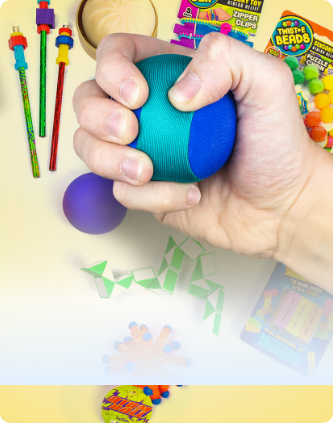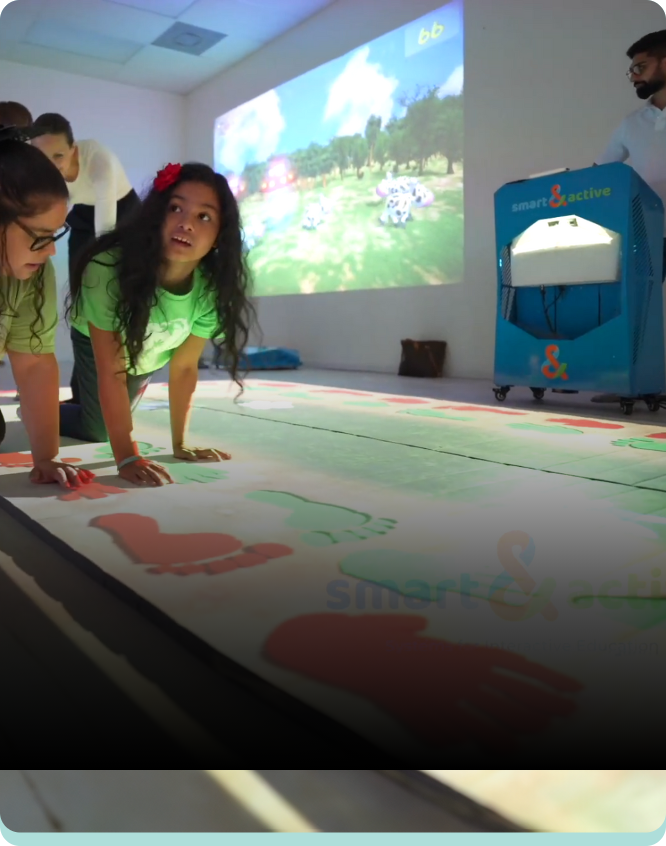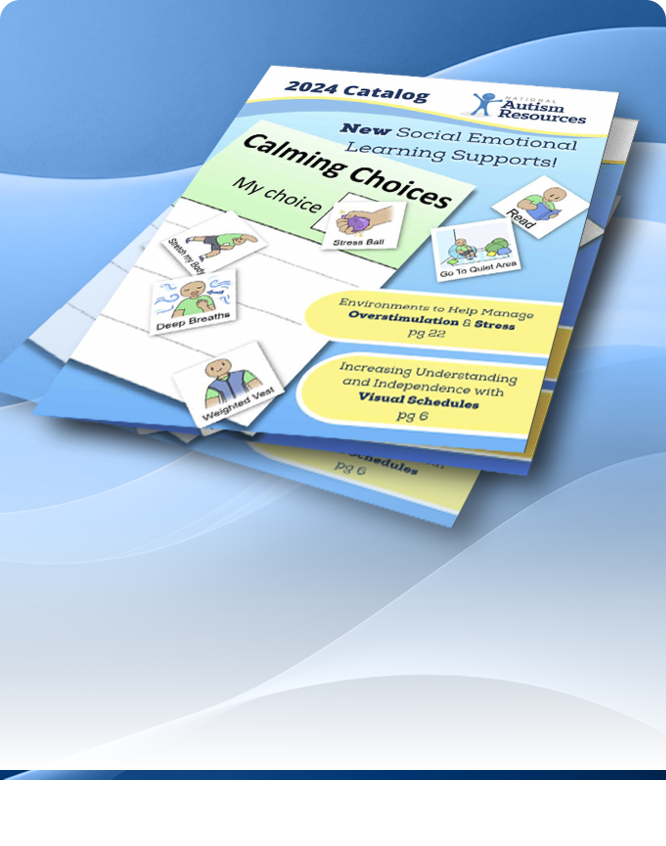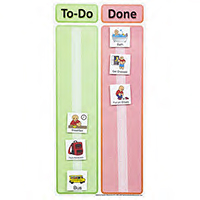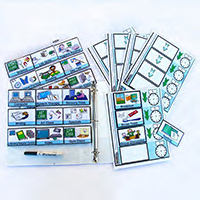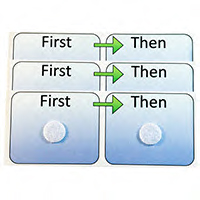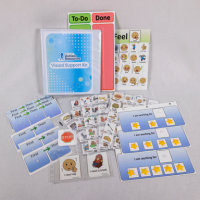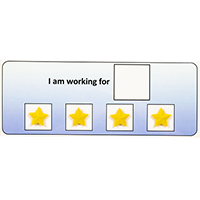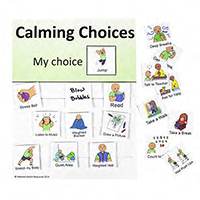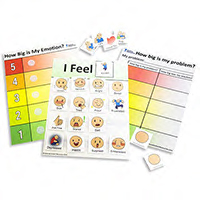What do you do when you have a new student, with autism, added to your class but no background in special education? The following are common strategies that teachers can use to support students with autism in full inclusion settings:
- Use Visual Schedules and Supports to Build Independence
- Use Reward Systems to Promote Positive Behaviors
- Prepare for Over-stimulation, Stress, or Possible Meltdowns
- Teach Transitions & Waiting Strategies
- Create Accommodations for Stimming Behavior & Movement
Use Visual Schedules and Supports to Build Independence
Most educators use some visual supports in their classroom. For example, writing the schedule for the day on the board is a visual support. It is something students can look at that helps them understand what the day will look like and what will be expected of them.
Visual Schedules:
There are several types of visual schedules that can work well to support students on the autism spectrum. Depending on your student's individual needs a visual schedule can decrease confusion, support independence, manage anxiety by preparing a student for transitions, and encourage on task behavior. Here are some common examples:
- Write the schedule on the board and check off each task as the class moves through the schedule, or give a student an individual checklist that they can check off tasks as they complete them.
- Use a pocket chart with images of each part of your schedule. As you complete the tasks take the task off the chart and put it in a finished pocket or envelope.
- You can use a To Do/Done Chart to help your student keep track of their schedule. As your student completes each part of the schedule they can move a picture from the “To Do” side to the “Done” side. This then prompts them to look at the next activity and can help with transitions. You can also create To Do/Done charts for specific activities during the day.
Label Everything
A label can be a word or a picture that quickly tells a student what something is or where it belongs. You can label workstations, shelves, and cabinets. If you expect your student to put their backpack in a certain spot, write the word backpack or hang a picture of a backpack in that area. Anytime your student seems to have trouble understanding where something goes is a good time to label it.
Color Coding
To promote independence you can also use color coding in your classroom. There are several ways to color code. You can assign a color to an area or station in your classroom. This can be done using colored chairs or by placing a piece of colored tape or construction paper on a table. For example, if you are using centers on your visual schedule, you could put a blue square next to the math station, a red square next to the reading station. You can also use colored tape to create visual boundaries in your classroom.
For more ideas read Using Visuals to Reduce Confusion and Frustration, and Encourage Independence.
Use Reward Systems to Promote Positive Behaviors
Promoting On Task Behavior Using First/Then
The First/Then strategy is a very common positive reinforcement strategy developed by David Permack (2). Basically you can motivate a student to do an unpreferred activity if you pair it with something they enjoy doing. You can do this verbally or with a First/Then chart.
As you think about your students schedule, try to pair activities that they highly prefer with ones they try to avoid. For example, if math is a challenge, schedule it right before snack time or recess. So when it's time for math you can say, “first the math sheet, then recess.” You can also use this strategy if your student is avoiding a behavior. For example, you could say: “first wash hands, then snack.”
First Then Next Chart
An extension of the strategy above is the First, Then, Next chart. This slightly extends the demand on your student by asking them to do two things before the preferred activity. For example, “first math sheet, next quiz, then recess.”
Token Economy
A token economy is a strategy you can use to increase desirable behavior and decrease undesirable behavior. When using this strategy, you will give your students a token immediately after they do the desired behavior. Your student then exchanges a predetermined amount of tokens for an object or privilege they desire. You can use this system to encourage a wide variety of positive behaviors. Your student can earn a token for every five math problems they finish, or for every 15 minutes they stay seated, or for keeping their hands to themselves while waiting in line.
A token economy is often far more effective than discipline or "taking away" a privilege. For this to be effective the goals have to be manageable and attainable. Lets apply this to a student who does not want to sit through circle time. You can set up a reward system so that they can earn a token for every five minutes they stay seated.
If your student only stays seated for three minutes you can tell them, "you were so close we have to reset the timer, but try again and see if you can get a token for sitting for five minutes." There is still an opportunity to succeed and a motivation to exhibit the positive behavior. If on the other hand you say, "you didn't sit through circle time so I can't give you a (reward)" once the student fails, there is no motivation to exhibit the positive behavior because there is no possibility of a reward.
Choice Board
Whenever possible offer a choice for your students. The theory behind this is that by choosing an option it helps your student to emotionally “buy into” the activity. You can ask the student if they want to work on the spelling sheet or the math sheet. Do you want to write with the blue pencil or the red pencil. The key here is that the student does not get to create their own choice.
For more information on Choice Boards and Visual Schedules click here.
Prepare for Overstimulation, Stress, or Possible Meltdowns
Preparing ahead for emotional outbursts or meltdowns is a must do strategy for inclusion success. During these times both the student and staff experience stress, and it’s hard to handle them effectively without a plan.
The best remedy is prevention. It is important that you talk to your student’s family or past staff, so that you can understand and recognize what frustration signs look like in your student. If you have support staff in your classroom make sure they also know what to look for.
Often stress happens when someone new is working with a student with autism. Remember to communicate across team members and especially with new members. This can be as simple as creating a short “cheat sheet.” Along with therapy goals make a list of behaviors to watch for that indicates stress, successful calming techniques and contact information for the team leader or primary caregiver in case a quick consultation is needed.
For the plan to be successful, you need to prepare and practice a calming routine. There are several strategies you can use for your calming plan:
Offer a Calming Area
It can be fairly easy to create a safe area your student can go to when they are feeling stressed. A calming area can be a beanbag in the corner of your classroom with a pair of noise cancelling headphones and a clipboard your student can use to finish an assignment. Another option is to place a small area rug with calming items behind a teacher’s desk. It can be a quiet corner in the office that your student can walk to when they need a break. For your calming area to be effective your student must view this area as a safe place, not a punishment or “time out” area.
We have found the following calming items to be helpful:
- Weighted Items: blankets, vests, lap pads, or weighted stuffed animals provide deep pressure that helps the muscles in the body to let go of tension.
- A soft vibrating massage pillow allows a child to provide themselves with calming vibration. Pressure activated pillows also encourage some isometric exercise.
- Some children find it very calming to put interesting things to touch in a box. This can include soft swatches of fabric, fidgets, or small stuffed animals.
Offer Breaks
You can offer “break” cards. Your student can use a break card when they are feeling anxious, frustrated with a task, bored, overwhelmed with an area (cafeteria or assembly), or if they need a break from spending time with a person.
Teach Calming Exercises
Two simple physical exercises you can teach your student to help calm down are deep breathing and isometric exercises. When a student becomes stressed or overwhelmed their heart rate increases and their breathing becomes fast and shallow. This creates high blood pressure. You can help a student stop this cycle by simply learning to take deep breaths.
Deep breathing is a simple stress management tool that a child can use anywhere to calm and re-center themselves. It's important to teach and practice this technique often before stressful situations arise. If your student has trouble with the concept of breathing in and out you can use a Hoberman sphere to teach this concept.
You can also trigger your muscles to let go of tension by doing some simple isometric exercises. Stop for a moment and squeeze your hands together then open them. As you open your hands you should notice your muscles are more relaxed than before you started. Here are some simple isometric exercises:
- Making a fist and squeezing
- Pushing hands together
- Pushing knees together
- Shrug your shoulders
- Pushing against a wall
- Pulling against a rope tied around a pole on the playground
For a student who is having difficulty understanding the concept of isometric exercise, give them a stress ball to squeeze. You can place the stress ball between their hands, knees, elbows or shoulder and neck to help them learn this relaxation technique.
During a Meltdown, Remember the rule of one.
Use the rule of one when a student is deeply stressed, anxious or in the middle of a meltdown. Have only one person talk to the student with autism and ask them to do only one thing. Unfortunately most school models of crises call for bringing in lots of people that start talking at once. Rather than calming a situation down this can escalate it. Remember to just have one person, ideally the person who has genuine affection for the student, ask the student to do only one thing. The task should be something simple. Some examples could be, sit in a chair, go to your calm place, or take some deep breaths.
Provide Accommodations for Stimming Behavior & Movement
Repetitive movements like hand flapping, jumping or making noises are most likely strategies your student is using to help them self-sooth and stay calm. Often called “stimming” because it is considered a self stimulatory behavior, it is usually linked to strong emotions (such as excitement or frustration). You may see your student exhibit this behavior when they are feeling overwhelmed, upset, or really happy. Although this behavior can be distracting in your classroom, you want to accommodate it since is is often a self regulation tool that can keep a student’s behavior from escalating.
To help with stimming you can also provide discreet movement opportunities. This can include giving the student a fidget or something quiet and interesting to hold or manipulate, a chair band to kick against while they are sitting, or a wiggle seat they can sit and move on while doing their work. These small accommodations provide lots of movement opportunities for your student with minimal distraction..
You can allow your student to stand at their desk and work so that they can jump or move while they are completing their work. If this behavior is distracting the other students consider seating your student with autism in the back of the class to help minimize distractions.
Finally, remember if you've met one student with autism, you've met one student with autism. Not all of these suggestions will be helpful for every student. Remember to be patient with yourself and your student as you both learn to work together.
Sources:


